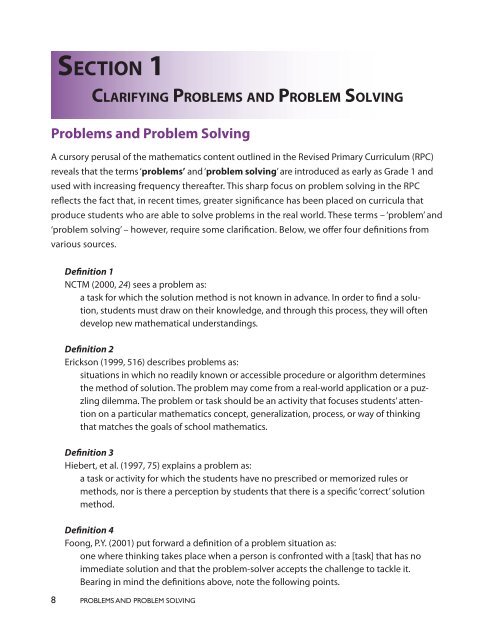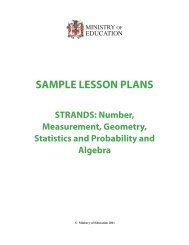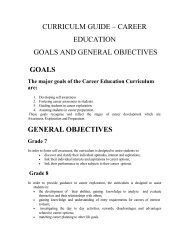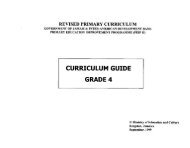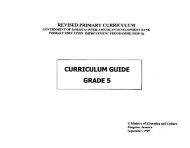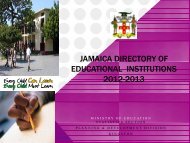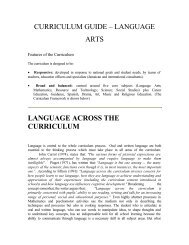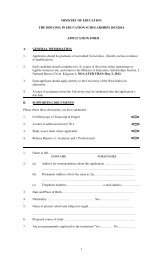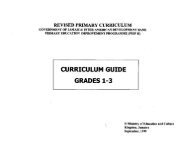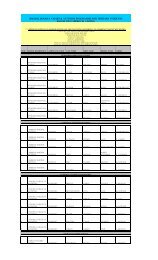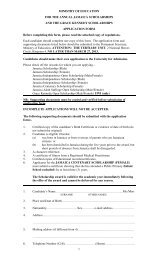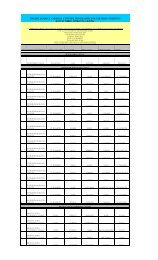Problems and Problem Solving - Ministry of Education
Problems and Problem Solving - Ministry of Education
Problems and Problem Solving - Ministry of Education
Create successful ePaper yourself
Turn your PDF publications into a flip-book with our unique Google optimized e-Paper software.
se c t I o n 1<br />
clArIFyIng pr o B l e m s A n d pr o B l e m so l V I n g<br />
<strong><strong>Problem</strong>s</strong> <strong>and</strong> <strong>Problem</strong> <strong>Solving</strong><br />
A cursory perusal <strong>of</strong> the mathematics content outlined in the Revised Primary Curriculum (RPC)<br />
reveals that the terms ‘problems’ <strong>and</strong> ‘problem solving’ are introduced as early as Grade 1 <strong>and</strong><br />
used with increasing frequency thereafter. This sharp focus on problem solving in the RPC<br />
reflects the fact that, in recent times, greater significance has been placed on curricula that<br />
produce students who are able to solve problems in the real world. These terms – ‘problem’ <strong>and</strong><br />
‘problem solving’ – however, require some clarification. Below, we <strong>of</strong>fer four definitions from<br />
various sources.<br />
Definition 1<br />
NCTM (2000, 24) sees a problem as:<br />
a task for which the solution method is not known in advance. In order to find a solution,<br />
students must draw on their knowledge, <strong>and</strong> through this process, they will <strong>of</strong>ten<br />
develop new mathematical underst<strong>and</strong>ings.<br />
Definition 2<br />
Erickson (1999, 516) describes problems as:<br />
situations in which no readily known or accessible procedure or algorithm determines<br />
the method <strong>of</strong> solution. The problem may come from a real-world application or a puzzling<br />
dilemma. The problem or task should be an activity that focuses students’ attention<br />
on a particular mathematics concept, generalization, process, or way <strong>of</strong> thinking<br />
that matches the goals <strong>of</strong> school mathematics.<br />
Definition 3<br />
Hiebert, et al. (1997, 75) explains a problem as:<br />
a task or activity for which the students have no prescribed or memorized rules or<br />
methods, nor is there a perception by students that there is a specific ‘correct’ solution<br />
method.<br />
Definition 4<br />
Foong, P.Y. (2001) put forward a definition <strong>of</strong> a problem situation as:<br />
one where thinking takes place when a person is confronted with a [task] that has no<br />
immediate solution <strong>and</strong> that the problem-solver accepts the challenge to tackle it.<br />
Bearing in mind the definitions above, note the following points.<br />
8 PROBLEMS AND PROBLEM SOLVING<br />
<strong>Problem</strong><strong>Solving</strong>.indd 8<br />
8/24/12 6:55:33 PM


